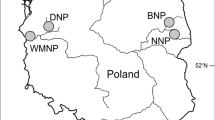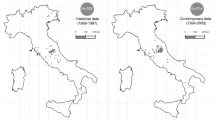Abstract
As part of a conservation initiative, we released captive-bred individuals of European mink (Mustela lutreola) onto a Baltic island ‘sanctuary’, Hiiumaa (Estonia), and investigated the development of their diet in the wild. Fifty-four animals out of the 172 released were equipped with radio collars and tracked in 2000–2003 intensively after release. Based on the analysis of the contents of 564 collected scats, we monitored how the diet of released individuals changed after release and how this was affected by habitat and by season. Diet changed as they adapted to the wild: some prey consumed immediately after release were later substituted with prey more typical of wild European mink elsewhere. The mink’s tendency to take typical prey increased (crayfish, 3; fish, 1.5; and small mammals, 2 times), while the proportion of atypical prey decreased more than five times in 60 days after release. Once established in the wild, the composition of the diet and its variation between seasons, habitats or weather conditions were similar to that reported elsewhere for wild European mink. There is no indication therefore that the components of the diet provided in captivity persisted in the wild after the adaptation period. We suggest that the adaptation of released carnivores to natural prey merits more attention in reintroduction projects.




Similar content being viewed by others
References
Biggins DE, Godbey JL, Hanebury LR, Luce B, Marinari PE, Matchett MR, Vargas A (1998) The effect of rearing methods on survival of reintroduced black-footed ferrets. J Wildl Manag 62:643–653
Böhme G (1977) Zur Bestimmung quartarer Anuren Europas an Hand von Skelettelementen. Wissenschaftliche Zeitschrift der Humboldt-Universität zu Berlin. Mathematisch-Naturwissenschaftliche Reihe 26:283–300
Breitenmoser U, Breitenmoser-Würsten C, Carbyn LN, Funk SM (2001) Assessment of carnivore introductions. In: Gittleman JL, Funk SM, Macdonald DW, Wayne RK (eds) Carnivore conservation. University Press, Cambridge, pp 241–281
Danilov PI, Tumanov IL (1976) The ecology of the European and American mink in the Northwest of the USSR. In: Ecology of birds and mammals in northwest of the USSR. Akad Nauk Karelski filial, Inst Biol, pp 118–143
Derbot S, Fivaz G, Mermod C, Weber J-M (1982) Atlas des poils de mammiferes d’Europe. University of Neuchâtel, Switzerland
Fischer J, Lindenmayer DB (2000) An assessment of published results of animal relocations. Biol Conserv 96:1–11
Griffith B, Scott JM, Carpenter JW, Reed C (1989) Translocation as species conservation tool: status and strategy. Science 245:477–480
Harrington LA, Harrington AL, Hughes J, Stirling D, Macdonald DW (2010) The accuracy of scat identification in distribution surveys: American mink in the northern highlands of Scotland. Eur J Wildl Res 56:377–384
Hayward MW, Somers MJ (2009) Reintroduction of top-order predators. Wiley-Blackwell, Oxford, 459
Hellstedt P, Kallio ER (2005) Survival and behaviour of captive-born weasels (Mustela nivalis nivalis) released in nature. Journal of Zoology 266:37–44
Jedrzejewska B, Jedrzejewski W (1998) Predation in vertebrate communities: the Bialowieza primeval forest as a case study. Springer, Berlin, p 450
Jule KR, Leaver LA, Lea EGL (2008) The effects of captive experience on reintroduction survival in carnivores: a review and analysis. Biol Conserv 141:355–363
Klare U, Kamler JF, Macdonald DW (2011) A comparison and critique of different scat analysis methods for determining carnivore diet. Mamm Rev 41:294–312
Kleiman DG, Mallinson JJC (1998) Recovery and management committees for lion tamarins: partnerships in conservation planning and implementation. Conserv Biol 12:27–38
Macdonald DW (2009) Lessons learnt and plans laid: seven awkward questions for the future of reintroduction. In: Hayward MW, Somers MJ (eds) Reintroduction of top-order predators. Wiley-Blackwell, pp 411–448
Macdonald DW, Sidorovich VE, Maran T, Kruuk H (2002) The Darwin initiative. European mink, Mustela lutreola: analyses for conservation. Wildlife Conservation Research Unit, University of Oxford, pp 122
Maran T (2003) European mink: setting of goal for conservation and Estonian case study. Galemys 15:1–11
Maran T (2006) Conservation of the European mink in Estonia: an update 2001–2003. In: International Conference on the Conservation of European mink (Mustela lutreola). Logroño, pp131–142
Maran T (2007) Conservation biology of the European mink, Mustela lutreola (Linnaeus 1761): decline and causes of extinction. Dissertations, Tallinn University
Maran T, Henttonen H (1995) Why is the European mink (Mustela lutreola) disappearing? A review of the process and hypotheses. Annal Zoolo Fenn 32:47–54
Maran T, Kruuk H, Macdonald DW, Põlma M (1998a) Diet of two species of mink in Estonia: displacement of Mustela lutrola by Mustela vison. Journal of Zoology 245:218–222
Maran T, Macdonald DW, Kruuk H, Sidorovich V, Rozhnov VV (1998b) The continuing decline of the European mink, Mustela lutreola: evidence for the intraguild aggression hypothesis. In: Dustone N, Gorman ML (eds) Behaviour and ecology of riparian mammals. Symposia of the Zoological Society of London, Cambridge University Press, pp 297–324
Maran T, Põdra M, Põlma M, Macdonald DW (2009) The survival of captive-born animals in restoration programmes—case study of the endangered European mink Mustela lutreola. Biol Conserv 142:1685–1692
Maran T, Skumatov D, Palazón S, Gomez A, Põdra M, Saveljev A, Kranz A, Libois R, Aulagnier S (2011) Mustela lutreola. In: IUCN 2011. IUCN Red List of Threatened Species, Version 2011.2. www.iucnredlist.org
März R (1987) Gewöll-und Rupfungskunde. Akademie Verlag Leipzig, pp 86–100
Miländer G (1993) Beetles (Coleoptera) in Hiiumaa. Pirrujaak (2). Biosphere Reserve Hiiumaa Center, pp 120
Põdra M, Maran T (2003) Management plan of the European mink, Mustela lutreola, in Hiiumaa (2004–2008). Foundation Lutreola, Kärdla-Tallinn, p 109
Puzek Z (1981) Keys to vertebrates of Poland mammals. Polish Scientific, Warszawa, p 367
Reading PR, Clark TW (1996) Carnivore introductions: an interdisciplinary examination. In: Gittleman JL (ed) Carnivore behavior, ecology and evolution. Cornell University Press, Ithaca, pp 296–336
Seddon PJ (1999) Persistence without intervention: assessing success in wildlife reintroductions. Trends Ecol Evol 14:503–503
Seddon PJ, Soorae PS, Launay F (2005) Taxonomic bias in reintroduction projects. Anim Conserv 8:51–58
Seddon PJ, Armstrong DP, Maloney RF (2007) Developing the science of reintroduction biology. Conserv Biol 21:303–312
Sidorovich VE (1997) Mustelids in Belarus. Evolutionary ecology, demography and interspecific relationships. Zolotoy Uley, Minsk, p 289
Sidorovich VE (2000) Seasonal variation in the feeding habits of riparian mustelids in river valleys of NE Belarus. Acta Theriol 45:233–242
Sidorovich V (2001) Study on the decline in the European mink Mustela lutreola population in connection with the American mink M. vison expansion in Belarus: story of the study, review of the results and research priorities. Säugetierkundliche Informationen 5:133–154
Sidorovich V, Macdonald DW (2001) Density dynamics and changes in habitat use by the European mink and other native mustelids in connection with the American mink expansion in Belarus. Neth J Zool 51:107–126
Sidorovich VE, Kruuk H, Macdonald DW, Maran T (1998) Diets of semi-aquatic carnivores in northern Belarus, with implications for population changes. In: Dustone N, Gorman ML (eds) Behaviour and ecology of riparian mammals. Symposia of the Zoological Society of London, Cambridge University Press, Cambridge, pp 177–190
Sidorovich V, Macdonald DW, Pikulik MM, Kruuk H (2001) Individual feeding specialization in the European mink, Mustela lutreola and the American mink, Mustela vison in north-eastern Belarus. Folia Zoolog 50(1):27–42
Sjoasen T (1996) Survivorship of captive-bred and wild-caught reintroduced European otters Lutra lutra in Sweden. Biol Conserv 76:161–165
Smeeton C, Weagle K (2000) The reintroduction of the swift fox Vulpes velox to South Central Saskatchewan, Canada. Oryx 34:171–179
Spalton JA, Lawrence MW, Brend SA (1999) Arabian oryx reintroduction in Oman: successes and setbacks. Oryx 33:168–175
Steinmetz B, Müller R (1991) An atlas of fish scales and other bony structures used for age determination. Gardigan, Samara, p 51
Vargas A, Lockhart M, Marinari P, Gober P (1998) Preparing captive-raised black-footed ferrets Mustela nigripes for survival after release. Dodo J Wildlife Preserv Trusts 34:76–83
Vargas A, Gober P, Lockhart M, Marinari M (2000) Black-footed ferrets: recovering an endangered species in an endangered habitat. In: Griffith HI (ed) Mustelids in a modern world. Backhuys, Leiden, pp 97–105
Wolf CM, Garland T, Griffith B (1998) Predictors of avian and mammalian translocation success: reanalysis with phylogenetically independent contrasts. Biol Conserv 86:243–255
Youngman P (1990) Mustela lutreola. Mammalian Species 362:1–3
Zabala J, Zuberogoitia I (2003) Badger, Meles meles (Mustelidae, Carnivora), diet assessed through scat-analysis: comparison and critique of different methods. Folia Zoolog 52(1):23–30
Zabala J, Zuberogoitia I, Martínez JA (2006) Factors affecting occupancy by the European mink in South-Western Europe. Mammalia 3:193–201
Zabala J, Zuberogoitia I, Martínez JA (2007) Modelling the incidence of fragmentation at different scales in the European mink (Mustela lutreola) population and the expansion of the American mink (Mustela vison) in Biscay. Small Carniv Conserv 36:14–17
Zidon R, Saltz D, Shore L, Motro U (2009) Behavioral changes, stress, and survival following reintroduction of Persian fallow deer from two breeding facilities. Conserv Biol 23:1026–1035
Zuberogoitia I, Zabala J (2003) Do European mink use only rivers or do they also use other habitats? Small Carniv Conserv 28:7–8
Acknowledgments
The release operation in Hiiumaa was financially supported by the Darwin Initiative, EU LIFE Project No. LIFE2000NAT/EE/7081, Foundation LUTREOLA, Zoos Help Foundation, Bernhandine Foundation, Denver Zoological Society, Thoiry Zoological Park, GaiaPark, Helsinki Zoo and Zoological Society for Conservation of Species and Populations. The project was also supported by Tallinn Zoo, Rotterdam Zoo and Hiiumaa County Department of the Estonian Ministry of the Environment, State Nature Conservation Centre and Tallinn University. Valuable assistance in analysing the scats was received from I. Solovej and L. Kõlamets and in editing the manuscript from M. Maran. We are also grateful to both reviewers and editor for their useful comments and suggestions.
Author information
Authors and Affiliations
Corresponding author
Additional information
Communicated by C. Gortázar
Rights and permissions
About this article
Cite this article
Põdra, M., Maran, T., Sidorovich, V.E. et al. Restoration programmes and the development of a natural diet: a case study of captive-bred European mink. Eur J Wildl Res 59, 93–104 (2013). https://doi.org/10.1007/s10344-012-0653-z
Received:
Revised:
Accepted:
Published:
Issue Date:
DOI: https://doi.org/10.1007/s10344-012-0653-z




